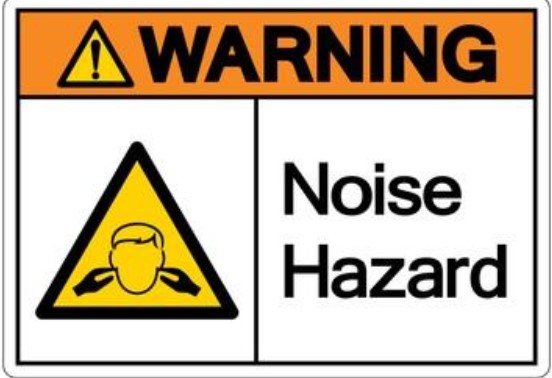Introduction
Noise is often called the “invisible hazard” in the workplace. Unlike obvious dangers such as moving machinery or hazardous chemicals, noise cannot be seen. However, it can permanently damage your hearing and affect your overall health. Noise hazards in the workplace have been recognized globally as a significant occupational safety issue. If ignored, they can lead to irreversible Noise-Induced Hearing Loss (NIHL), reduced productivity, and even workplace accidents due to communication problems and lack of awareness.
Unfortunately, noise exposure often goes unnoticed because the effects develop gradually, and workers may not realize the damage until it’s too late. This makes it essential for both employers and workers to understand and mitigate the risks associated with noise hazards.

Common Causes of Noise Hazards
Workplace noise can come from many sources, and it’s not always linked to heavy industry. In fact, many workers in seemingly quieter environments are exposed to hazardous noise levels. Some common causes of noise hazards include:
1. Industrial Machinery
Presses, grinders, compressors, and generators are common sources of noise in industries like manufacturing, construction, and automotive. These machines often generate noise above 85 dB, which is the safe exposure limit set by OSHA.
2. Construction Equipment
Drills, jackhammers, and pile drivers in construction sites are among the loudest tools, often exceeding 100 dB. Workers in these environments are at high risk of developing NIHL if proper hearing protection isn’t provided.
3. Manufacturing Lines
Packaging machines, conveyor belts, and other mechanical systems used in manufacturing can create noise levels ranging from 85 dB to 95 dB. These repetitive, high-decibel sounds can cause cumulative hearing damage over time.
4. Transport and Logistics
Airplanes, trains, forklifts, and heavy trucks are a constant source of noise in transportation and logistics sectors. Workers at airports, railway stations, and loading docks are exposed to hazardous noise levels, particularly in busy transportation hubs.
5. Entertainment Venues
Nightclubs, concerts, and cinemas generate loud amplified sounds that exceed 85 dB for extended periods. Workers in these environments, such as sound engineers, performers, and security personnel, are at risk for tinnitus and hearing loss if proper protections are not used.
In many cases, workers are exposed to noise levels above the safe limit of 85 dB set by OSHA noise standards. For example, jet engines can reach up to 140 dB, and jackhammers can produce noise levels of 120 dB, making it crucial for employers to mitigate these risks.
Risks Associated with Noise Hazards
Long-term exposure to high noise levels doesn’t just result in hearing problems. It can lead to a range of health issues and decreased productivity. Some of the key risks associated with noise exposure include:
1. Noise-Induced Hearing Loss (NIHL)
Permanent damage to hearing ability is one of the most well-known consequences of prolonged exposure to high noise levels. Noise-induced hearing loss (NIHL) happens when the inner ear hair cells are overstimulated and destroyed by loud sounds. Unfortunately, NIHL is irreversible, making it a permanent impairment.
2. Tinnitus
Tinnitus refers to the persistent ringing, buzzing, or humming sounds in the ears that result from exposure to loud noise. Tinnitus can be incredibly disruptive, affecting sleep, concentration, and overall quality of life. It is often the first sign of noise damage.
3. Stress & Fatigue
Constant exposure to noise increases stress hormone levels in the body, which can result in chronic stress and mental fatigue. Workers exposed to high noise levels experience increased irritability, reduced concentration, and a decrease in cognitive performance, which ultimately affects productivity and decision-making.
4. Communication Difficulties
High levels of noise in the workplace make verbal communication difficult, increasing the likelihood of miscommunication. In environments such as construction or manufacturing, where clear communication is crucial for safety, communication barriers can lead to accidents and errors.
5. Increased Accident Risk
Noise exposure can also increase the risk of workplace accidents by masking warning sounds or emergency alarms. For example, in a factory setting, workers may fail to hear the sound of an approaching forklift or a fire alarm, increasing the risk of accidents.
6. Cardiovascular Problems
Studies have shown that chronic exposure to loud noise is linked to an increased risk of high blood pressure and heart disease. Noise-induced stress over time contributes to the development of cardiovascular problems, making it a serious long-term health concern.
How to Identify Noise Hazards
Employers and safety officers need to actively identify and assess noise hazards in the workplace. Key steps for identifying noise hazards include:
1. Conduct Noise Surveys
Noise surveys using sound level meters are essential for determining the noise levels in different areas of the workplace. By measuring sound intensity, employers can determine which areas have unsafe noise levels and need noise control interventions.
2. Check Communication Requirements
One simple indicator of excessive noise is whether workers raise their voices to communicate with others. If workers must shout to be heard from just a meter away, the noise level is likely above safe limits.
3. Maintain Records of Daily Exposure
Keep records of daily noise exposure for workers in high-risk areas, such as manufacturing floors or construction sites. By tracking exposure patterns, employers can proactively address and mitigate risks.
Preventing Noise Hazards
The most effective approach to controlling noise hazards is to use the hierarchy of controls, which prioritizes eliminating noise at the source, implementing engineering and administrative controls, and using personal protective equipment (PPE). Here’s a breakdown of the strategies:
1. Eliminate the Source
Where possible, replace loud machinery with quieter models or redesign work processes to reduce noise at the source. For example, using electric machinery instead of gas-powered equipment can reduce noise levels significantly.
2. Engineering Controls
Install soundproof barriers or acoustic panels to reduce the transmission of sound.
Use vibration dampeners on equipment to reduce noise generated by moving parts.
Enclose noisy equipment or create physical barriers between high-noise areas and quieter zones.
3. Administrative Controls
Rotate workers in noisy areas to limit the amount of time each worker spends exposed to loud noise.
Schedule noisy tasks during off-peak hours or when fewer workers are present to reduce overall exposure.
Establish quiet zones in break rooms to allow workers time to recover from the effects of noise exposure.
4. Personal Protective Equipment (PPE)
Provide hearing protection (earplugs or earmuffs) for workers exposed to noise above the recommended limits.
Ensure that PPE is properly fitted and comfortable to encourage workers to use it consistently.
Training & Awareness
No prevention program is complete without workplace safety training. Workers should be educated about the risks associated with noise hazards and the importance of protecting their hearing. Training should cover:
The health effects of noise and how to recognize early signs of hearing damage.
Proper use of hearing protection (earplugs, earmuffs) and its maintenance.
Importance of regular hearing tests to monitor hearing health.
Reporting noise-related symptoms early, such as tinnitus or difficulty hearing instructions.
Conclusion
Noise hazards are a silent threat that can have serious long-term consequences if left unaddressed. Occupational noise exposure leads to hearing loss, tinnitus, stress, and communication problems, all of which can impact workers’ health, productivity, and safety.
By implementing effective noise control measures, conducting regular noise monitoring, and ensuring workers use personal protective equipment properly, employers can protect employees from the harmful effects of excessive noise.
Ultimately, reducing noise hazards is not just about compliance—it’s about ensuring a healthier, safer, and more productive workforce. With proactive noise management, businesses can protect hearing, reduce accidents, and improve employee well-being.

